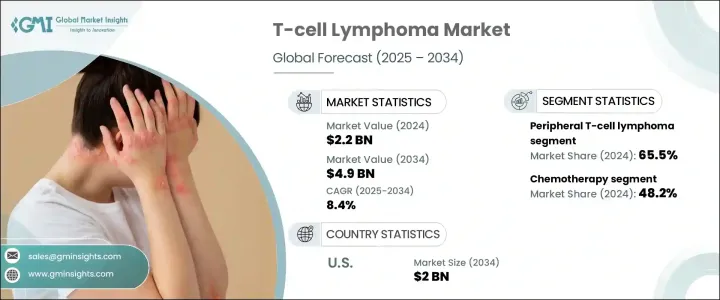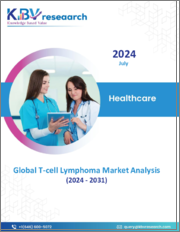
|
시장보고서
상품코드
1708135
T세포 림프종 시장 기회, 성장 촉진요인, 산업 동향 분석, 예측(2025-2034년)T-cell Lymphoma Market Opportunity, Growth Drivers, Industry Trend Analysis, and Forecast 2025 - 2034 |
||||||
세계 T세포 림프종 시장은 2024년 22억 달러로 평가되며 2025년부터 2034년까지 CAGR 8.4%로 성장할 것으로 예상되며, T세포 림프종은 희귀하고 공격적인 비호지킨림프종으로 유병률 증가와 효과적인 치료법의 시급한 필요성으로 인해 큰 주목을 받고 있습니다. 이 질환은 T 림프구의 급속하고 비정상적인 증식으로 인해 면역 체계를 약화시키고 심각한 합병증을 유발합니다. 세계 인구의 고령화, 유전자 변이, 만성 감염 등의 요인이 시장을 주도하고 있습니다. 질병에 대한 인식이 높아지고 진단의 발전으로 조기 발견율이 높아짐에 따라 표적 치료제에 대한 수요가 증가하고 있습니다.

시장은 혁신적인 치료법 발견에 초점을 맞춘 연구개발 활동이 급증하고 있습니다. 정밀의료, 면역치료의 발전, 표적 치료제의 도입은 치료 프로토콜에 혁명을 가져왔고, 환자들에게 새로운 희망을 가져다주었습니다. 그러나 제한된 치료 옵션, 높은 개발 비용, 엄격한 규제 프레임워크는 여전히 장애물로 작용하고 있습니다. 제약사들은 승인된 치료법의 폭을 넓히기 위해 임상시험에 대한 투자를 늘리고 있으며, 환자들의 치료 결과를 개선하기 위한 시급한 요구에 부응하고 있습니다. 새로운 치료법에 대한 FDA 승인 건수의 증가는 의료비 지출 증가와 함께 시장 확대를 더욱 가속화하고 있습니다.
| 시장 범위 | |
|---|---|
| 시작 연도 | 2024년 |
| 예측 연도 | 2025-2034년 |
| 시작 금액 | 22억 달러 |
| 예상 금액 | 49억 달러 |
| CAGR | 8.4% |
말초성 T세포 림프종(PTCL) 분야는 2024년 65.5%의 점유율을 차지했으며, PTCL은 T세포 림프종 중 가장 공격적인 병형 중 하나이며, 특히 고령자 및 유전적 소인을 가진 사람들에게서 높은 유병률을 보입니다. 예후가 좋지 않고 5년 생존율이 낮기 때문에 혁신적인 치료법에 대한 수요가 급증하고 있습니다. 단클론항체 및 면역관문억제제를 포함한 표적 치료제의 개발이 이 분야의 큰 성장을 견인할 것으로 예상됩니다. 제약사들은 생존율을 개선하고 치료 효과를 높일 수 있는 약물 개발에 우선순위를 두고 있으며, 이는 미충족된 임상적 니즈에 대한 시장의 지속적인 노력을 반영하고 있습니다.
시장은 화학요법, 면역요법, 방사선요법, 줄기세포 이식, 기타 치료법으로 구분됩니다. 화학요법은 여전히 주요 치료법으로 2024년 48.2%의 점유율을 차지했습니다. 화학요법은 부작용이 많음에도 불구하고 PTCL과 같은 공격성이 높은 아형 치료에 효과적이기 때문에 널리 사용되고 있습니다. 화학요법과 줄기세포 이식 및 면역치료의 통합은 환자의 예후를 개선하고 치료 성공률을 높이고 있습니다. 연구자들은 독성을 최소화하고 효능을 높이는 새로운 제제를 지속적으로 연구하고 있으며, 병용요법의 발전은 화학요법의 시장에서의 우위를 더욱 강화시키고 있습니다.
북미 T세포 림프종 시장은 2024년 9억 7,000만 달러에 달했으며, 미국이 이 지역의 성장을 주도할 것으로 예상됩니다. FDA는 조기 승인, 희귀질환 치료제 지정, 우선 심사 등을 통해 혁신적인 치료법 개발을 적극 장려하고 있으며, 강력한 규제 프레임워크와 정부 지원책이 결합되어 시장 확대를 촉진하고 있습니다. 이러한 규제적 인센티브를 통해 제약사들은 의약품 개발에 많은 투자를 하게 되었고, 결국 환자들의 치료 선택권이 확대되고 있습니다. 그 결과, T세포 림프종 치료의 미래를 형성하는 지속적인 발전으로 북미 시장은 선도적인 위치를 유지할 것으로 예상됩니다.
목차
제1장 조사 방법과 조사 범위
제2장 주요 요약
제3장 업계 인사이트
- 산업 생태계 분석
- 업계에 대한 영향요인
- 성장 촉진요인
- T세포 림프종 이환율 상승
- 표적요법과 면역요법의 진보
- 인지도 향상과 조기 진단
- 암 연구 및 임상시험에 대한 투자 증가
- 업계의 잠재적 리스크·과제
- 고액의 치료비
- 한정된 치료 효과와 높은 재발율
- 성장 촉진요인
- 성장 가능성 분석
- 규제 상황
- 격차 분석
- 특허 분석
- 파이프라인 분석
- Porters 분석
- PESTEL 분석
제4장 경쟁 구도
- 소개
- 기업 시장 점유율 분석
- 기업 매트릭스 분석
- 주요 시장 기업 경쟁 분석
- 경쟁 포지셔닝 매트릭스
- 전략 대시보드
제5장 시장 추정과 예측 : 유형별, 2021-2034년
- 주요 동향
- 말초성 T세포 림프종(PTCL)
- 혈관 면역아구성 T세포 림프종(AITL)
- 미분화 대세포 림프종(ALCL)
- 피부 T세포 림프종(CTCL)
- 기타 PTCL
- 림프모구성 T세포 림프종(T-LBL)
제6장 시장 추정과 예측 : 치료법별, 2021-2034년
- 주요 동향
- 화학요법
- 면역요법
- 방사선 치료
- 줄기세포 이식
- 기타 치료
제7장 시장 추정과 예측 : 지역별, 2021-2034년
- 주요 동향
- 북미
- 미국
- 캐나다
- 유럽
- 독일
- 영국
- 프랑스
- 스페인
- 이탈리아
- 네덜란드
- 아시아태평양
- 중국
- 일본
- 인도
- 호주
- 한국
- 라틴아메리카
- 브라질
- 멕시코
- 아르헨티나
- 중동 및 아프리카
- 남아프리카공화국
- 사우디아라비아
- 아랍에미리트
제8장 기업 개요
- Acrotech Biopharma
- Affimed
- Bristol Myers Squibb Company
- Chipscreen Biosciences
- Citius Pharma
- Daiichi Sankyo Company
- Dizal Pharma
- Eisai
- Genor Biopharma
- Gilead Sciences
- Innate Pharma
- Johnson & Johnson
- Merck &Co.
- Novartis
- Takeda Pharmaceuticals
The Global T-Cell Lymphoma Market was valued at USD 2.2 billion in 2024 and is projected to grow at a CAGR of 8.4% between 2025 and 2034. T-cell lymphoma, a rare and aggressive form of non-Hodgkin lymphoma, is gaining significant attention due to its increasing prevalence and the urgent need for effective treatments. The disease results from the rapid and abnormal proliferation of T-lymphocytes, which weakens the immune system and leads to severe complications. Factors such as an aging global population, genetic mutations, and chronic infections are driving the market forward. As awareness about the disease grows and diagnostic advancements improve early detection rates, the demand for targeted therapies is rising.

The market is witnessing a surge in research and development activities focused on discovering innovative treatment approaches. The introduction of precision medicine, immunotherapy advancements, and targeted drug therapies is revolutionizing treatment protocols, thus offering new hope for patients. However, challenges such as limited treatment options, high costs associated with drug development, and stringent regulatory frameworks continue to pose hurdles. Pharmaceutical companies are increasingly investing in clinical trials to expand the range of approved therapies, addressing the pressing need for better patient outcomes. The growing number of FDA approvals for novel treatments, coupled with increasing healthcare expenditure, is further accelerating market expansion.
| Market Scope | |
|---|---|
| Start Year | 2024 |
| Forecast Year | 2025-2034 |
| Start Value | $2.2 Billion |
| Forecast Value | $4.9 Billion |
| CAGR | 8.4% |
The peripheral T-cell lymphoma (PTCL) segment dominated the market, holding a 65.5% share in 2024. PTCL is one of the most aggressive forms of T-cell lymphoma, with a particularly high prevalence among older adults and individuals with genetic predispositions. Due to its poor prognosis and low five-year survival rate, there is a pressing demand for innovative therapies. The development of targeted therapies, including monoclonal antibodies and immune checkpoint inhibitors, is expected to drive significant growth in this segment. Pharmaceutical companies are prioritizing the development of drugs that can improve survival rates and enhance treatment efficacy, reflecting the market's ongoing commitment to addressing unmet clinical needs.
The market is segmented into chemotherapy, immunotherapy, radiation therapy, stem cell transplantation, and other treatment options. Chemotherapy remains the leading treatment method, accounting for a 48.2% share in 2024. Despite its significant side effects, chemotherapy is widely used due to its effectiveness in treating aggressive subtypes such as PTCL. The integration of chemotherapy with stem cell transplantation and immunotherapy is improving patient outcomes and enhancing treatment success rates. Ongoing advancements in combination therapies are further reinforcing chemotherapy's dominance in the market as researchers continue to explore new formulations that minimize toxicity and increase efficacy.
North America T-Cell Lymphoma Market reached USD 900.7 million in 2024, with the United States leading the region's growth. A strong regulatory framework, coupled with supportive government initiatives, is fostering market expansion. The FDA has been actively encouraging the development of innovative therapies through accelerated approval pathways, orphan drug designations, and priority reviews. These regulatory incentives are driving pharmaceutical companies to invest heavily in drug development, ultimately expanding treatment options for patients. As a result, the North American market is expected to maintain its leadership position, with continuous advancements shaping the future of T-cell lymphoma treatments.
Table of Contents
Chapter 1 Methodology and Scope
- 1.1 Market scope and definitions
- 1.2 Research design
- 1.2.1 Research approach
- 1.2.2 Data collection methods
- 1.3 Base estimates and calculations
- 1.3.1 Base year calculation
- 1.3.2 Key trends for market estimation
- 1.4 Forecast model
- 1.5 Primary research and validation
- 1.5.1 Primary sources
- 1.5.2 Data mining sources
Chapter 2 Executive Summary
- 2.1 Industry 360° synopsis
Chapter 3 Industry Insights
- 3.1 Industry ecosystem analysis
- 3.2 Industry impact forces
- 3.2.1 Growth drivers
- 3.2.1.1 Rising incidence of T-cell lymphomas
- 3.2.1.2 Advancements in targeted therapies and immunotherapy
- 3.2.1.3 Increasing awareness and early diagnosis
- 3.2.1.4 Rising investments in cancer research and clinical trials
- 3.2.2 Industry pitfalls and challenges
- 3.2.2.1 High cost of treatment
- 3.2.2.2 Limited treatment efficacy and high relapse rates
- 3.2.1 Growth drivers
- 3.3 Growth potential analysis
- 3.4 Regulatory landscape
- 3.5 Gap analysis
- 3.6 Patent analysis
- 3.7 Pipeline analysis
- 3.8 Porter's analysis
- 3.9 PESTEL analysis
Chapter 4 Competitive Landscape, 2024
- 4.1 Introduction
- 4.2 Company market share analysis
- 4.3 Company matrix analysis
- 4.4 Competitive analysis of major market players
- 4.5 Competitive positioning matrix
- 4.6 Strategy dashboard
Chapter 5 Market Estimates and Forecast, By Type, 2021 – 2034 ($ Mn)
- 5.1 Key trends
- 5.2 Peripheral T-cell lymphoma (PTCL)
- 5.2.1 Angioimmunoblastic T-cell lymphoma (AITL)
- 5.2.2 Anaplastic large cell lymphoma (ALCL)
- 5.2.3 Cutaneous T-cell lymphoma (CTCL)
- 5.2.4 Other PTCL
- 5.3 Lymphoblastic T-cell lymphoma (T-LBL)
Chapter 6 Market Estimates and Forecast, By Therapy, 2021 – 2034 ($ Mn)
- 6.1 Key trends
- 6.2 Chemotherapy
- 6.3 Immunotherapy
- 6.4 Radiation therapy
- 6.5 Stem cell transplantation
- 6.6 Other treatment types
Chapter 7 Market Estimates and Forecast, By Region, 2021 – 2034 ($ Mn)
- 7.1 Key trends
- 7.2 North America
- 7.2.1 U.S.
- 7.2.2 Canada
- 7.3 Europe
- 7.3.1 Germany
- 7.3.2 UK
- 7.3.3 France
- 7.3.4 Spain
- 7.3.5 Italy
- 7.3.6 Netherlands
- 7.4 Asia Pacific
- 7.4.1 China
- 7.4.2 Japan
- 7.4.3 India
- 7.4.4 Australia
- 7.4.5 South Korea
- 7.5 Latin America
- 7.5.1 Brazil
- 7.5.2 Mexico
- 7.5.3 Argentina
- 7.6 Middle East and Africa
- 7.6.1 South Africa
- 7.6.2 Saudi Arabia
- 7.6.3 UAE
Chapter 8 Company Profiles
- 8.1 Acrotech Biopharma
- 8.2 Affimed
- 8.3 Bristol Myers Squibb Company
- 8.4 Chipscreen Biosciences
- 8.5 Citius Pharma
- 8.6 Daiichi Sankyo Company
- 8.7 Dizal Pharma
- 8.8 Eisai
- 8.9 Genor Biopharma
- 8.10 Gilead Sciences
- 8.11 Innate Pharma
- 8.12 Johnson & Johnson
- 8.13 Merck & Co.
- 8.14 Novartis
- 8.15 Takeda Pharmaceuticals



















